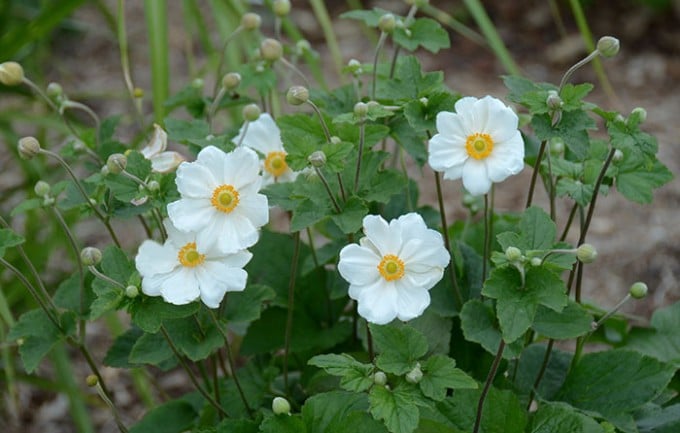
Although the season is beginning to gently shut down, the parade of Japanese anemones is carrying on in my garden. First to bloom was ‘September Charm’ (Anemone x hybrida ‘September Charm’, Zone 6), with pink petals (technically tepals) and a darker pink flush on the reverse. It began blooming at the beginning of August and will continue for four weeks. My favourite of these plants is sparkling white ‘Honorine Jobert’ (A. x hybrida ‘Honorine Jobert’, Zone 6). It begins flowering about the middle of September, and I’m looking forward to the display this year.
‘Honorine Jobert’ is a tall plant, sending up sturdy 48-inch (120-cm) stems carrying lots of daisy-like flowers with flat white petals and bright yellow stamens surrounding a button centre. This cultivar is part of the tallest group of fall anemones, and it blooms in partial shade under a weeping ‘Red Jade’ crabapple tree. By happy coincidence, its flowers open just when the crabapple fruits are at the peak of their red colour, making an ideal combination. The tall stature of ‘Honorine Jobert’ gives it architectural presence, and is certainly part of the plant’s allure. I’d like to pair it with other tall perennials of similar heights blooming at the same time, such as dusty pink Joe Pye weed (Eupatorium maculatum Atropurpureum Group, Zone 4) and the tall autumn coneflower with reflexed gold petals and tall brown centres (Rudbeckia laciniata ‘Herbstsonne’, Zone 6).
Considering how much pleasure Japanese anemones provide, I think the garden could accommodate a few more. I’m looking for ‘Lady Gilmour’ (48 inches / 120 cm), with two-tone pink petals and leaves partially crimped and curled like parsley. If you like the idea of two-tone petals (light pink flushed with darker pink), but want a more compact plant, try ‘Margarete’ (36 inches / 90 cm) or ‘Hadspen Abundance’ (32 inches / 80 cm). The deepest colours I’ve seen are on deep rose-pink ‘Serenade’ (40 inches / 100 cm), and ‘Pretty Lady Susan’ (16 inches / 40 cm) with dark pink-purple flowers and glowing yellow centres.
If you’re looking for something special, keep an eye out for Wild Swan Japanese anemone (A. x ‘Macane001’), a super hybrid developed through tissue culture. Wild Swan is a tall, robust plant with white blossoms, each flushed with violet-purple on the reverse of the tepals. It blooms from mid-June through frost.
I’m of two minds about some of the more extreme double Japanese anemones, such as bright pink ‘Party Dress’ (36 inches / 90 cm) with exceptionally large flowers of twisted and whorled petals surrounding a vivid orange-gold ring of stamens. The extra petals do make a more dynamic flower, but it begins to look like a dahlia to me. (However, you may well not think of dahlias at all when you see it.) Two semi-doubles, light pink ‘Alice’ (27 inches / 70 cm) and white ‘Whirlwind’ (30 inches / 75 cm), are more restrained and manage to be double without becoming dahlia-like.
Japanese anemones are ideal plants for partial shade in areas that receive reasonable moisture throughout the growing season. They don’t need copious amounts of irrigation, but they do resent drought and dry soil, so be sure to think of them when rain is infrequent. It’s a mistake to remove the anemone stems as soon as the plants finish blooming, as I learned one late autumn. I had done virtually no garden cleaning, and noticed the anemones seedheads were opening into fuzzy white balls that bobbed about in the frosty breeze. This was an added bonus from an obliging plant that wants nothing more than a partly shaded spot to bloom its head off from late summer through frost.

Honorine and the earlier pink anemones are workhorses in my garden. They bloom every year on strong stems which never need staking. I love them.
Wondering how you control the invasive spread of Anemone. I have September Charm and it is popping up everywhere in a wide swath from underground runners from the main plant. Tried digging some of them up but they continue to come back and spread. Love the way the plant looks in bloom but thinking of taking it out because of it’s intensive spread.
the Honorine jobert are simply gorgeous and I would
love to have them in my new ‘all white’ garden bed.
Pamela